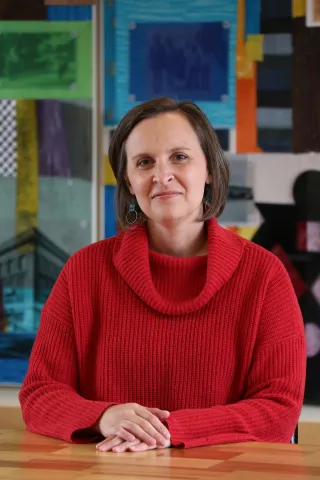
This month, we’re thinking about pathways after high school. Graduating seniors have plenty of viable options after high school, including college, training, service, and employment. What can the data tell us about these pathways? Let’s take a look.
The college pathway
The vast majority of high school students are thinking about college after high school. When asked in 11th grade, 82% of high school juniors said they expect to attend college after graduating. Four in six expect to enroll in a four-year degree program and one in six expects to enroll in a two-year degree program.

Four-year degree programs
Sixty-five percent of high school juniors expect to enroll in a four-year degree program after high school. In practice, about 45% of graduating seniors actually go on to enroll in a four-year degree program in the fall after graduation.
Where do students enroll? For students who stay in Minnesota, the top five institutions are mostly public institutions, with the University of St. Thomas sneaking in at fourth place. For students that leave the state, the top five institutions are in Wisconsin, North Dakota, and South Dakota, three states with which Minnesota has tuition reciprocity
Top five in-state and out-of-state four-year colleges by Minnesota high school students immediately enrolling in fall, 2022
| In-state | Out-of-state | |||
|---|---|---|---|---|
| Institution | Enrollment | Institution | Enrollment | |
| 1 | University of Minnesota—Twin Cities | 3,947 | North Dakota State University—Main Campus |
1,184 |
| 2 | Minnesota State University—Mankato | 1,750 | University of Wisconsin—Eau Claire | 702 |
| 3 | University of Minnesota—Duluth | 1,409 | University of Wisconsin—Madison | 584 |
| 4 | University of St. Thomas | 950 | University of North Dakota | 525 |
| 5 | Winona State University | 796 | South Dakota State University | 517 |
Source: Minnesota Statewide Longitudinal Education Data System (SLEDS) https://sleds.mn.gov/
For four-year students that stay in Minnesota, it’s welcome news that degree completion rates at our four-year postsecondary institutions are the highest we’ve seen in nearly two decades. Two-thirds of first-time, full-time undergraduate students graduate within 150% of “normal” program time, or within six years of starting their programs. This is higher than completion rates in Wisconsin, North Dakota, and South Dakota, the three states with which Minnesota has tuition reciprocity.

Private colleges top the list for four-year degree completion rates, but the University of Minnesota–Twin Cities rounds out the top five institutions with 84% of first-time, full-time undergraduates completing their degrees within six years.
| Institution | ||
|---|---|---|
| 1 | Carleton College | 94% |
| 2 | Macalester College | 93% |
| 3 | College of Saint Benedict | 85% |
| 4 | Saint Olaf College | 85% |
| 5 | University of Minnesota—Twin Cities | 84% |
Two-year degree programs
At 17%, the next largest share of high school juniors expect to enroll in a two-year degree program after high school. In practice, about 21% of graduating seniors actually go on to enroll in a two-year degree program in the fall after graduation. This slight increase in actual enrollment, over expectation, may reflect a range of factors including cost, alignment with career and life goals, and accessibility.
In this case, where do students enroll? It is much more common for two-year students to stay put in Minnesota. Indeed, proximity to home – in addition to cost, flexibility, workforce training, teaching quality, and class size, among others – can be one of the draws offered by local community colleges.
Top five two-year colleges by Minnesota high school students immediately enrolling in fall, 2020
| Institution | Enrollment | |
|---|---|---|
| 1 | Normandale Community College | 1,220 |
| 2 | Century College | 947 |
| 3 | Anoka-Ramsey Community College | 906 |
| 4 | North Hennepin Community College | 602 |
| 5 | Rochester Community and Technical College | 581 |
Source: Minnesota Statewide Longitudinal Education Data System (SLEDS), https://sleds.mn.gov/.
For two-year programs, we tend to look at combined rates of degree completion plus transfer, since transferring college credits to another program (i.e., a four-year program) may be the goal for some students. Degree completion plus transfer rates at Minnesota’s two-year postsecondary institutions tend to hover a bit over 50%. Today, 56% of first-time, full-time two-year students graduate within 150% of “normal” program time, or within three years of starting their programs. We rank among the top 10 states in the nation on this measure.
Two-year institutions in the central and northern portions of the state top the list for degree completion plus transfer rates.
Top five two-year colleges by degree completion plus transfer rates, 2020
| Institution | ||
|---|---|---|
| 1 | Minnesota State Community and Technical College (Fergus Falls, MN) | 92% |
| 2 | Rainy River Community College (International Falls, MN) | 72% |
| 3 | Alexandria Technical & Community College (Alexandria, MN) | 71% |
| 4 | Hibbing Community College (Hibbing, MN) | 65% |
| 5 | Vermilion Community College (Ely, MN) | 64% |
Source: National Center for Education Statistics, Integrated Postsecondary Education Data System (IPEDS), http://nces.ed.gov/ipeds/.
Two years after receiving an associate’s degree, about 38% of degree recipients are working full-time, year-round, and median annual wages are around $34,100.
Read PART 2 of our "Navigating life" series, where we'll look at other pathways for high school graduates.
